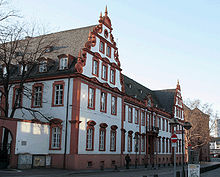Schönborner Hof (Mainz)
The Schönborner Hof is an aristocratic court in Mainz . It was the seat of the noble family von Schönborn, who were important after the Thirty Years' War in the electoral Mainz .
Establishment
The Schönborner Hof was built between 1668 and 1670 at the north-western end of what was then Thiermarkt (today's Schillerplatz ) in Mainz. Despite its structural similarities to the House of the Roman Emperor , built in the late Renaissance style, it is already considered to be the first noble court in Mainz to be built in the new Baroque style . It served as the Mainz city residence of the Counts of Schönborn, who originally came from the Taunus and later mainly worked in Franconia .
The client was the Mainz privy councilor Philipp Erwein von Schönborn , the younger brother of the then reigning Elector of Mainz and Archbishop Johann Philipp von Schönborn . The Mainz builder Clemens Hinck is responsible for the design of the main building . The adviser behind this was probably the builder of the Marienberg (later Zum Römischen Kaiser) on Liebfrauenplatz , Edmund Rokoch. The similarity of the facades with their roll-work gables and bay windows reinforces this view. At that time the courtyard had only one upper floor and a risalit with Renaissance stepped gables on one side. The architects Dientzenhofer , the family architect from Bamberg, as well as Maximilian von Welsch and Balthasar Neumann for later renovations are also considered as stylistic advisors .
Gardens
The farm owned significant, extensive baroque gardens , the so-called Schönborn garden in the early Baroque style. These were described in more detail by Nikolaus Person (before 1648–1710), an important cartographer and engraver from Mainz, in his book Novum architectuae speculum . The three-part systems to the side of the main building encompassed the entire area of the large square and the former barracks on Münsterstrasse and today's provisions store. It bordered to the west on Altmünsterstrasse and to the south on the convent of the white women nuns.
Almost all of the aristocratic families in Mainz at that time had larger gardens that bordered the adjacent hills and were therefore usually terraced. The Schönbornsche garden was designed after the model of the formal French baroque garden: Broderieparterre , water features , fountains and garden house with loggias.
expansion
The first extensions took place as early as 1706 and in 1773 the complex was supplemented by the so-called Wichernhaus. Towards the end of the 18th century, in 1798, the courtyard was rededicated as a barracks and hospital under French rule. In the 19th century, the Schönborn court became an officer's mess. It was raised by one storey and lost its characteristic gable.
The gardens were given up in 1863 when the neighboring provisions store and the Prince Karl barracks were built. In the summer of 2002 a baroque fountain was found next to the food store as the last remnant of the garden.
Destruction and rebuilding
After severe damage in the Second World War , the 2nd floor was removed again and the state of the 17th century was reconstructed, the northern risalit was set back a little from the original line in order to widen the Schillerstrasse in front of it.
Todays use
As early as 1946 , a French study center was set up in Mainz by Raymond Schmittlein (Directeur Général des Affaires Culturelles in the French zone of occupation ), which later assumed the name Maison de France and found a prestigious place of work in the Schönborn court. There is still an institute français in the premises of the Schönborner Hof today .
The aim of the institute or the “Maison” has been to make the French culture, the language and France better known and to promote the further development of intercultural exchange. In addition to language courses and a multi-faceted cultural program, a large media library in Schönborner Hof today offers a large selection with over 12,000 French-language media: In addition to classic works of literature and modern books on current problems and challenges of today's society in France, daily newspapers on various topics are available. The most famous French newspapers and magazines such as Le Monde , Liberation , Paris-Match or l'Histoire can be read there. The media library also offers a large selection of French films and CDs as well as 1,500 books and comics for young people and a separate children's section.
In 1994, a communal cinema was set up under the name CinéMayence, operated by the Mainz association AG Stadtkino eV in a hall that had served as the institute's film room as early as the 1950s. The cinema takes part in the Kino Vino program of the Rhineland-Palatinate Ministry of Viticulture.
Furthermore, the University of Mainz has been using parts of the building for several years. The Institute for Prehistory and Protohistory has a large library.
The state university treasury of the state of Rhineland-Palatinate has been housed in the Wichernhaus of the Schönborner Hof since 1995.
The Mainz Schoppenstecher statue is in the remaining green space between the Schönborner Hof and the provisions office .
literature
- Rolf Dörrlamm, Susanne Feick, Hartmut Fischer, Hans Kersting: Mainz contemporary witnesses made of stone. Architectural styles tell 1000 years of history. Verlag Hermann Schmidt, Mainz, 2001, ISBN 3-87439-525-1 .
Web links
- Institut français Mainz
- CinéMayence
- CinéMayence on the Mainz site
- State University Fund Mainz
- Article in AZ-Mainz ( Memento from March 13, 2007 in the Internet Archive )
- The Schönborner Hof in Mainz by Bernhard Peter (especially on heraldry)
Coordinates: 49 ° 59 '55.82 " N , 8 ° 15' 58.86" E
